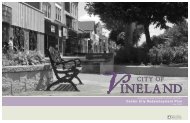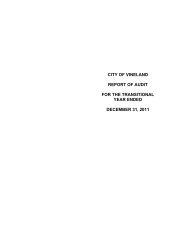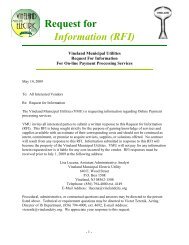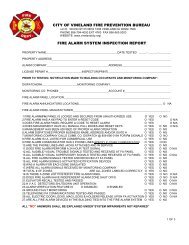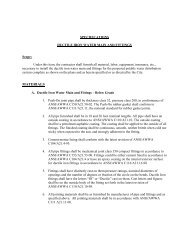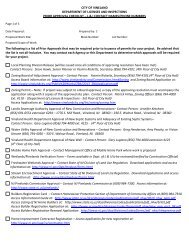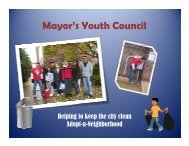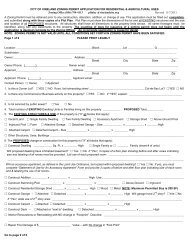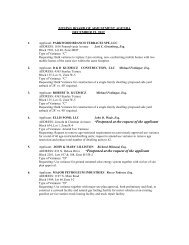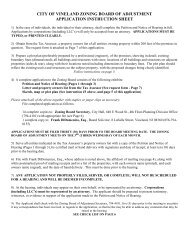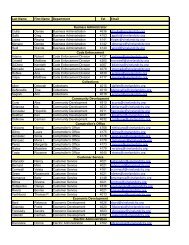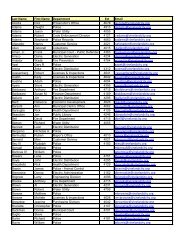Land Use Ordinance - June 2008 - City of Vineland
Land Use Ordinance - June 2008 - City of Vineland
Land Use Ordinance - June 2008 - City of Vineland
You also want an ePaper? Increase the reach of your titles
YUMPU automatically turns print PDFs into web optimized ePapers that Google loves.
<strong>City</strong> <strong>of</strong> <strong>Vineland</strong><br />
<strong>Land</strong> <strong>Use</strong> <strong>Ordinance</strong> Amendment<br />
Zoning<br />
(1) Piggery.<br />
(2) Animal or poultry processing (slaughtering).<br />
F. Residential Cluster in the R-5 Zone.<br />
Residential cluster design within the R-5 zone may better advance the intent and purpose <strong>of</strong> the<br />
<strong>City</strong> Master Plan for the protection <strong>of</strong> the environment and the conservation <strong>of</strong> open space.<br />
provided that the overall intensity <strong>of</strong> the cluster does not exceed the intensity <strong>of</strong> a permitted<br />
conventional development. Accordingly, a residential cluster <strong>of</strong> single family dwellings may be<br />
permitted as an alternative form <strong>of</strong> development in the R-5 zone on a contiguous land area that is<br />
to be developed as a single entity according to a plan that preserves a significant area <strong>of</strong> open<br />
space. The Planning Board may approve a residential cluster where it determines that the intent<br />
and purpose <strong>of</strong> the <strong>City</strong> Master Plan is better served by the cluster design and that the<br />
development meets the requisite standards and criteria for the residential cluster option.<br />
(1) Cluster Option. Cluster development may be permitted at the option <strong>of</strong> the <strong>City</strong> Planning<br />
Board as an alternative to conventional development. The Planning Board may permit the<br />
cluster option where the applicant demonstrates that, compared to a conventional layout,<br />
the cluster design will benefit the community in the following ways: by conserving natural<br />
resources; by preserving open spaces; by better protecting areas that are particularly<br />
susceptible to erosion and sediment loss; by reducing impervious surfaces; by better<br />
protecting natural drainage features and vegetation; by minimizing land disturbance from<br />
clearing and grading; by minimizing soil compaction; by reducing the use <strong>of</strong> stormwater<br />
management basins; by promoting the use <strong>of</strong> vegetated open-channel drainage systems that<br />
discharge into and through stable vegetated areas; and by reducing the need for additional<br />
infrastructure. For purposes <strong>of</strong> evaluating the cluster option, the applicant shall submit a lot<br />
yield map <strong>of</strong> a conforming conventional subdivision layout. The Planning Board shall<br />
compare the benefit <strong>of</strong> the cluster subdivision plan to the conventional subdivision plan by<br />
considering the following factors: reduction in the total area <strong>of</strong> land disturbance; reduction<br />
in the total area <strong>of</strong> impervious coverage; reduction in the total length <strong>of</strong> new streets;<br />
reduction in the construction <strong>of</strong> new structural drainage facilities; and the preservation <strong>of</strong><br />
trees and woodland.<br />
A-10



